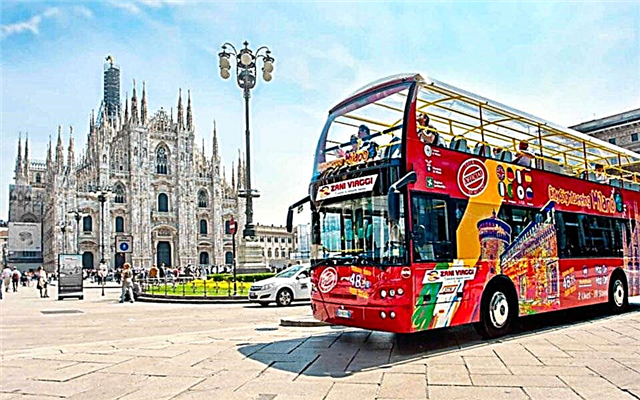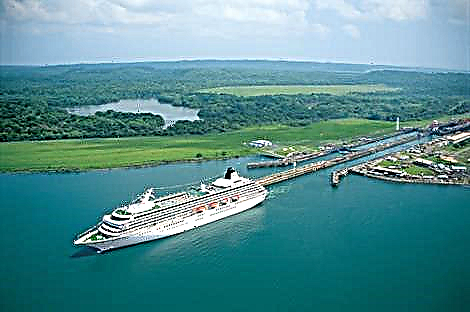The first public railway was opened two centuries ago, in England. In the 21st century, there are no railways in only one fifth of all countries of the world. Sometimes this type of transport is not needed due to the small size of the country, as in San Marino and St. Lucia. In some places, the construction of roads is hindered by the small infrastructure and economic development of the state, as in several African countries.
But for most people, the train has long become a priority way of moving: such a trip is often cheaper than on an airplane, and is more comfortable than on a car or bus. And also, choosing this type of transport, you can visit the railway stations, which are sometimes not inferior in beauty and grace to cathedrals and palaces.
15 most luxurious train stations in the world
Chhatrapati Shivaji Station, Mumbai, India
 This 1887 property, protected by UNESCO, combines the architectural features of the Renaissance in Italy and the Mughal era. At the time of opening, the station was called Victoria Terminus - in honor of the British Queen Victoria, who at that time was just 50 years old. For several years, the station was completed, and new parts of the building were designed in such a way that they did not differ from the original design of the station.
This 1887 property, protected by UNESCO, combines the architectural features of the Renaissance in Italy and the Mughal era. At the time of opening, the station was called Victoria Terminus - in honor of the British Queen Victoria, who at that time was just 50 years old. For several years, the station was completed, and new parts of the building were designed in such a way that they did not differ from the original design of the station.
New York Central Station
 This is perhaps the most impressive train station in the United States. The waiting room with luxurious windows and columns seems to have been moved from the old vaulted church, and the facade of the building is decorated with a complex sculptural composition depicting Heracles, Minerva and Mercury. It is not surprising that the Grand Central Station is the sixth most visited tourist attraction in the world: 26 million people walk here every year.
This is perhaps the most impressive train station in the United States. The waiting room with luxurious windows and columns seems to have been moved from the old vaulted church, and the facade of the building is decorated with a complex sculptural composition depicting Heracles, Minerva and Mercury. It is not surprising that the Grand Central Station is the sixth most visited tourist attraction in the world: 26 million people walk here every year.
Liège-Guillemins Station, Liege, Belgium
 Most of the delightful train stations were built in the Victorian and Edwardian era - from the mid-19th to the early 20th century. But some modern railway stations can safely give odds to old buildings. These include the Liège Central Railway Station, which opened less than 10 years ago.
Most of the delightful train stations were built in the Victorian and Edwardian era - from the mid-19th to the early 20th century. But some modern railway stations can safely give odds to old buildings. These include the Liège Central Railway Station, which opened less than 10 years ago.
The building with a 32-meter monumental arch made of steel, glass and white concrete is considered one of the most important transportation hubs in the country.
St Pancras Station, London, UK
 Often called the "Railway Cathedral", this station with a century and a half history at one time boasted the largest single-span roof in the world. In the 60s of the 20th century, they decided to close the station because of its uselessness - desperate admirers of ancient architecture, including the famous poet John Begetman, saved the marvelous structure.
Often called the "Railway Cathedral", this station with a century and a half history at one time boasted the largest single-span roof in the world. In the 60s of the 20th century, they decided to close the station because of its uselessness - desperate admirers of ancient architecture, including the famous poet John Begetman, saved the marvelous structure.
Station Building in Dunedin, New Zealand
 In New Zealand's Dunedin, only 120 thousand people live, but twice as many tourists come here - people are attracted by the coolest street in the world, two ancient cathedrals and a train station built in the style of the Flemish Renaissance and nicknamed “Gingerbread George” (in honor of the architect, George Corpse). The New Zealand Sports Hall of Fame and the Otago Art Gallery fit on the top floor of an old building.
In New Zealand's Dunedin, only 120 thousand people live, but twice as many tourists come here - people are attracted by the coolest street in the world, two ancient cathedrals and a train station built in the style of the Flemish Renaissance and nicknamed “Gingerbread George” (in honor of the architect, George Corpse). The New Zealand Sports Hall of Fame and the Otago Art Gallery fit on the top floor of an old building.
Antwerp Central Station, Belgium
 Antwerp-Tsentral has been operating since 1905: twenty grades of construction in dark gray stone and marvelous marble, with a powerful glass dome and giant clocks, have been solved in a variety of architectural styles - it is too difficult to single out the main one. In 2014, the British-American magazine Mashable put Antwerp-Central on the first place in the list of the most impressive railway stations in the world.
Antwerp-Tsentral has been operating since 1905: twenty grades of construction in dark gray stone and marvelous marble, with a powerful glass dome and giant clocks, have been solved in a variety of architectural styles - it is too difficult to single out the main one. In 2014, the British-American magazine Mashable put Antwerp-Central on the first place in the list of the most impressive railway stations in the world.
Milan Central Station, Italy
 The king of Italy laid the first stone on the site of the future station in 1906, although they began to work on the station project only six years later. During the First World War, the country experienced a serious economic crisis, and the construction of the station proceeded extremely slowly, but initially the simple station design was complicated every year.
The king of Italy laid the first stone on the site of the future station in 1906, although they began to work on the station project only six years later. During the First World War, the country experienced a serious economic crisis, and the construction of the station proceeded extremely slowly, but initially the simple station design was complicated every year.
Later Benito Mussolini ordered to improve the building, seeing in it a symbol of the unlimited power of the fascist party. In the end, we got an unusual structure that combines a whole set of architectural features and styles and is of great interest to absolutely all tourists.
Sirkeci Station, Istanbul, Turkey
 Built almost 130 years ago, this beautiful station is considered one of the most striking examples of European orientalism: luxurious round stained-glass windows, a charming gray stone facade and carved turrets inspired more than one architect to create such masterpieces.
Built almost 130 years ago, this beautiful station is considered one of the most striking examples of European orientalism: luxurious round stained-glass windows, a charming gray stone facade and carved turrets inspired more than one architect to create such masterpieces.
It was at this station that the legendary Orient Express, coming from the capital of France through European countries, ended its long journey. Arriving in Constantinople could appreciate more than modern conveniences for those years - built-in gas lighting and heating using Austrian stoves.
Haydarpasa Station, Istanbul, Turkey
 Speaking about Istanbul, it is worth mentioning another luxury station - Khaidarpasha. The erection of the building in the neoclassical style was extremely difficult: the foundation of the object was laid on wooden piles driven into a soft coastline conquered from the sea. Rumor has it that the Turkish government plans to sell the old station along with the port and turn it into a luxury resort.
Speaking about Istanbul, it is worth mentioning another luxury station - Khaidarpasha. The erection of the building in the neoclassical style was extremely difficult: the foundation of the object was laid on wooden piles driven into a soft coastline conquered from the sea. Rumor has it that the Turkish government plans to sell the old station along with the port and turn it into a luxury resort.
Maputo Train Station, Mozambique
 This station, according to Newsweek, is one of the ten most beautiful railway stations in the world. A cozy white-green building with a number of majestic Victorian arches and columns - a child of Gustave Eiffel, a genius who created the famous Eiffel Tower a few years earlier. Today the station in Maputo is not only a railway depot, but also a cultural space where concerts and fashion shows are held.
This station, according to Newsweek, is one of the ten most beautiful railway stations in the world. A cozy white-green building with a number of majestic Victorian arches and columns - a child of Gustave Eiffel, a genius who created the famous Eiffel Tower a few years earlier. Today the station in Maputo is not only a railway depot, but also a cultural space where concerts and fashion shows are held.
Atocha Station, Madrid, Spain
 In 1892, under the strict guidance of the architect Alberto Palacio and the same Gustav Eiffel, the largest railway station in Madrid, Atocha, was built. The original building with massive wrought iron details was named after the nearby monastery of Our Lady of Atocha. In the center of today's station is a winter garden with spreading palm trees, tropical plants and a pond where turtles live.
In 1892, under the strict guidance of the architect Alberto Palacio and the same Gustav Eiffel, the largest railway station in Madrid, Atocha, was built. The original building with massive wrought iron details was named after the nearby monastery of Our Lady of Atocha. In the center of today's station is a winter garden with spreading palm trees, tropical plants and a pond where turtles live.
Kuala Lumpur Railway Station, Malaysia
 The elegant building of 1910 included a huge number of architectural elements inherent in Eastern and Western traditions, for which this station in various sources is called Neo-Moorish, Mughal or Indo-Saracen.
The elegant building of 1910 included a huge number of architectural elements inherent in Eastern and Western traditions, for which this station in various sources is called Neo-Moorish, Mughal or Indo-Saracen.
Helsinki Central Station, Finland
 This recognizable Finnish building is today considered a landmark abruptly on Senate Square or Sveaborg Fortress. Initially, the station was supposed to be “very Scandinavian” - in the national romantic style, but the locals demanded to create something more modern. Architect Eliel Saarinen obediently redone the plan, and already in 1919 the inhabitants of Helsinki were able to appreciate his architectural creation.
This recognizable Finnish building is today considered a landmark abruptly on Senate Square or Sveaborg Fortress. Initially, the station was supposed to be “very Scandinavian” - in the national romantic style, but the locals demanded to create something more modern. Architect Eliel Saarinen obediently redone the plan, and already in 1919 the inhabitants of Helsinki were able to appreciate his architectural creation.
Interestingly, the station has a private waiting room, designed exclusively for the President of Finland and official guests. This room was originally created for private use by the emperor of Russia, but the First World War delayed the grand opening of the station, and there, as we know, the emperor was gone.
North Station, Paris, France
 Built in the eclectic Boz-ar style, continuing the wonderful traditions of the Italian Renaissance and French Baroque, the North Station in Paris overshadows with its beauty more than one sight of the capital. The facade of the building is decorated with statues representing the main cities of Europe, and thanks to high arched windows, the hall is filled with soft golden light on sunny days. The support pillars inside the station were made at a Glasgow metallurgical plant - in all of Europe only in Scotland was a foundry where such global tasks could be performed.
Built in the eclectic Boz-ar style, continuing the wonderful traditions of the Italian Renaissance and French Baroque, the North Station in Paris overshadows with its beauty more than one sight of the capital. The facade of the building is decorated with statues representing the main cities of Europe, and thanks to high arched windows, the hall is filled with soft golden light on sunny days. The support pillars inside the station were made at a Glasgow metallurgical plant - in all of Europe only in Scotland was a foundry where such global tasks could be performed.
São Bento Station, Porto, Portugal
 The railway station in the Portuguese city, built on the site of an old monastery, is very reminiscent of a museum. And they come here to admire the fabulous panels on the walls, the first of which were created already in 1905.
The railway station in the Portuguese city, built on the site of an old monastery, is very reminiscent of a museum. And they come here to admire the fabulous panels on the walls, the first of which were created already in 1905.
These blue-white paintings of 20 thousand small tiles will lead an interested tourist through the difficult but interesting history of Portugal - here is the battle of Valdeves in the 12th century, in which Emperor Leon Alfonso VII bravely fought with his own brother, Afonso I the Great, the first king of Portugal; here is the wedding of the next Portuguese king Juan I in the 14th century, and the bloody battle of Ceuta in 1415, which marked the beginning of the era of European expansion.












